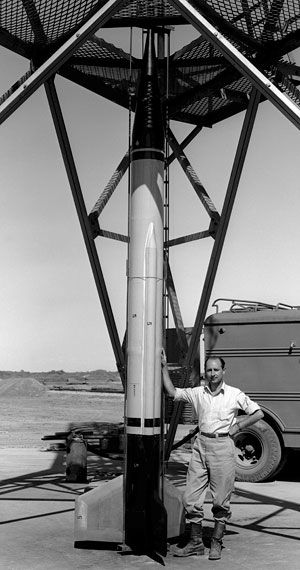
In the early decades of the 20th century, rocket science wasn’t considered the brainy endeavor it is now. Far from it: Simply expressing an interest in the field was enough to provoke ridicule. Becoming a rocket scientist was enough to get you ostracized from whatever field you were in before.
Frank Malina didn’t care. Overcoming incredible institutional resistance and rather daunting technical and financial odds, the engineer, while still a grad student at Caltech in the mid-1930s, started up a research program that would lay the foundations for U.S. rocket and missile development. During the run-up to World War II, that work took on new significance. By the war’s end, Malina had become the top American rocket expert and had cofounded the Jet Propulsion Laboratory, which today is one of the world’s premier space research organizations.
And yet, you’ve probably never heard of him. Most histories of the U.S. space program treat Malina and his group as a footnote. They say the real work started only after the war, with the arrival of Wernher von Braun, Hitler’s chief rocket scientist. Without the German’s genius, the story goes, U.S. extraterrestrial explorations would never have gone so far so fast.
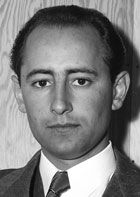
That version of events, though, overlooks the key contributions made by Malina and his team of engineers, scientists, and technicians, who not only advanced the state of rocketry but did so on a fraction of the funding that their German counterparts enjoyed. Between 1936 and 1946, Malina’s team pioneered the use of solid propellants, which in the decades following World War II became crucial in both missiles and launch vehicles, and they also did fundamental work with liquid propellants. Equally important was Malina’s institutional legacy, in cofounding both JPL and the Aerojet Engineering Corp. (now Aerojet Rocketdyne), a major aerospace player to this day.
What makes Malina’s story all the more compelling is that he was a man of great contradictions: A professed pacifist, he nevertheless designed powerful rockets to further the war effort. A communist sympathizer, he made a fortune through his stake in Aerojet. A consummate engineer, he opted to abandon his research career while still in his 30s and would eventually dedicate himself full-time to artistic pursuits. And yet, this sometimes deeply conflicted individual did more than anyone to legitimize the pursuit of rocket propulsion and to pave the way for others to pursue their paths to the stars.
Like most of the early rocketeers, Malina was drawn to the subject because rockets meant space travel. Born in 1912 in the tiny town of Brenham, Texas, Malina as a boy devoured Jules Verne’s classic From the Earth to the Moon, which vividly imagined an extraterrestrial trip. Even as an adolescent, Malina had an engineer’s mind-set. In a college essay on interplanetary travel, he enumerated the great difficulties that would need to be overcome, including the vast distances to traverse, the hostile atmosphere upon arrival, and the lack of any means of communication between that distant point and Earth.
In 1934, after getting a bachelor’s in mechanical engineering from Texas A&M University, he headed to Caltech. There, he had the good fortune to begin working for the renowned aerodynamicist Theodore von Kármán, who became his thesis advisor. Von Kármán led one of the world’s foremost centers of aeronautical research, the Guggenheim Aeronautical Laboratory, California Institute of Technology (GALCIT). As the limits of propeller propulsion for high-speed flight became obvious, von Kármán and others eagerly sought alternatives.

Late in 1935, after hearing a fellow student’s presentation on rocket-powered aircraft, Malina found his old interest in spaceflight rekindled. Coincidentally, a newspaper article about the presentation drew the attention of Pasadena resident John “Jack” Whitesides Parsons, a self-taught chemist who had been experimenting with powder rockets for some time. Parsons and a mechanic friend visited Caltech, seeking advice on building a liquid-propellant rocket. The student who’d given the presentation directed them to Malina, and Malina, recognizing what he would later describe as Parsons’s “uninhibited fruitful imagination,” agreed to work with Parsons.
Malina and Parsons were an odd pair. Methodical and reserved, the 23-year-old Malina was very much the academic. Parsons, two years younger, had enough ingenuity, boldness, and exuberance to more than compensate for the fact that he had no degree beyond high school. He also dabbled in magic and the occult. Somehow, this unlikely duo advanced rocket science further than either of them could have possibly done alone.
Malina proposed to von Kármán that he, Parsons, and Parsons’s mechanic friend, Ed Forman, design a sounding rocket that would carry scientific instruments into the upper atmosphere, to an altitude of about 40 kilometers. Despite the fact that Parsons and Forman had no Caltech affiliation, von Kármán agreed to support the trio, although he could provide only advice and use of the facilities but no actual funding. Over the next several years, Malina and his crew would pursue their investigations by taking part-time jobs, scrounging spare parts and materials where they could, and “borrowing” from university labs as needed. Malina and Parsons soon attracted additional graduate students to join them, including A.M.O. Smith, who would go on to become chief aerodynamicist at Douglas Aircraft, and Hsue-Shen Tsien, who would later return to China to found its missile and space program.
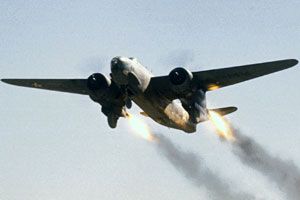
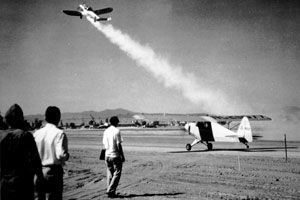
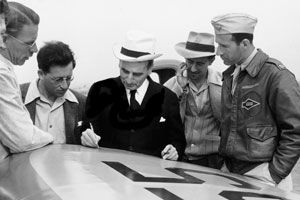
Rocketry was still in its infancy. Although rocket clubs in Europe and the United States gave amateurs an outlet for their interests, no serious university programs existed, and thus not much had been done to put theory into practice. Still, Malina’s group wasn’t quite starting from scratch. Back in the 1890s, Russian mathematician Konstantin Tsiolkovsky’s calculations showed that extraterrestrial travel via rocket propulsion was theoretically feasible. And in 1926, the secretive U.S. engineer Robert Goddard launched the world’s first liquid-fueled rocket. Its flight lasted just 2.5 seconds, rising to 12.5 meters. But his results inspired a new generation of rocket enthusiasts, including Malina and Parsons and also von Braun.
Consulting with von Kármán, Malina decided to focus first on the rocket engine. Up to then, nobody had built an engine suitable for a sounding rocket—that is, with enough thrust to reach an altitude of 40 km or so. Goddard’s rockets, for example, never got higher than 2.6 km. “Until one could design a workable engine with a reasonable specific impulse,” Malina later recalled, “there was no point in devoting effort to the design of the rocket shell, propellant supply, stabilizer, launching method, payload parachute, etc.” Parsons, who loved nothing more than the thrill of launching rockets, argued against Malina’s methodical approach. Fortunately for the sake of science, Malina won the argument.
The scientific rigor imposed by Malina didn’t stop the team from taking extraordinary risks. In one memorable experiment, a small rocket motor they were testing misfired, releasing a corrosive cloud of dinitrogen tetroxide that rusted equipment throughout the building. “We were told to move our apparatus outside the building at once,” Malina wrote. “We also were thereafter known at Caltech as the ‘Suicide Squad.’ ”
In late October 1936, the GALCIT rocketeers were ready to test their rocket motor. Given the likely noise and possibility of an explosion, they chose a spot off campus: the Arroyo Seco, a dry river basin on the western edge of Pasadena. Hauling their makeshift equipment out to the sand, they attached the motor to a 1-meter-tall stand, positioning it so that the exhaust flame would shoot straight up into the air. A spring would measure the rocket’s thrust. Hoses connected the motor to a tank of oxygen and another of methyl alcohol fuel. The tests would provide crucial data to back up their calculations, including fuel consumption, thrust, and temperatures and pressures inside the motor.
A cord fuse was supposed to ignite the fuel, but on the first three attempts it detached before it could be lit. On the fourth and final try, the fuse lit but then detached, managing to ignite some fuel that had spilled onto the equipment and also the oxygen hose. “The oxygen hose for some reason ignited and swung around on the ground, 40 feet from us,” Malina wrote the next day in a letter to his parents. “We all tore out across the country wondering if our check valves would work.” The check valves, designed to prevent the fuel and oxygen from backing up, did work, and although the resulting fire badly damaged their apparatus, the rocketeers were ecstatic. As Parsons and Forman already knew, there was just something awesome about setting things ablaze.
The group duly replaced the fuse with a spark plug, and on 15 November the motor burned for 5 seconds. Two weeks later, it fired for 20 seconds, this time with a deafening roar that indicated complete combustion. On their final test, on 16 January 1937, it burned for a full 44 seconds.
Over the next year and a half, the team continued their experiments as time and money allowed, and Malina published two landmark papers on their work in the Journal of the Aeronautical Sciences. Despite the rocketeers’ steady progress, however, their results drew little outside interest.
Then came the war. As hostilities in Europe and the Pacific deepened, U.S. military leaders began casting about for any new technologies that might assist in the war effort—including rockets. In December 1938, at von Kármán’s behest, Malina presented a report on “jet propulsion” to a group of government and military advisors in Washington, D.C. (He intentionally avoided the word “rockets,” which still had a poor reputation in scientific circles.) The report impressed the U.S. Army Air Corps’s commanding general, Henry “Hap” Arnold, who in January 1939 gave Malina’s group US $1,000 to develop rockets for jet-assisted takeoff (JATO). Six months later, Arnold gave them an additional $10,000. He hoped that JATO rockets, mounted on an airplane’s wings, might help a heavily laden aircraft take off from short island runways in the Pacific.
The group experimented with solid fuels, starting with the oldest: gunpowder. After a series of unintended explosions, Malina and von Kármán felt compelled to examine the theoretical stability of burning a solid fuel under pressure. Their conclusion, now known as the von Kármán–Malina theory of constant-thrust long-duration engines, showed the process could be made stable if the pressure inside the chamber remained constant. By the summer of 1941 the group’s gunpowder-based propellant was performing well enough to warrant flight tests on an actual aircraft. At March Field, in California, JATO rockets cut the takeoff distance of an Ercoupe, a fighter-size civilian aircraft, by half.
The engineers still had a problem. When the JATO rockets were stored for more than a few days, they would explode upon ignition. For the better part of a year, Parsons and Malina searched in vain for a solution. The bombing of Pearl Harbor in December 1941 only heightened the urgency.
Then, in June 1942, the self-taught Parsons had a brilliant insight. He was watching a construction crew mixing molten asphalt when it occurred to him that he could cast asphalt with an oxidizer, such as potassium perchlorate, to create a solid propellant. The combustible asphalt would act as both fuel and binder. The concept proved to be a fundamental technological breakthrough for all solid propellants, and Parsons’s idea lives on in both missiles and launch vehicles, including the Polaris, Minuteman, and Titan. That same year Malina, Parsons, von Kármán, and two others formed the Aerojet Engineering Corp. to manufacture JATO rockets for both the U.S. Army and Navy.
Of course, Malina and his colleagues weren’t the only rocketeers. In 1943 came British intelligence reports that the Germans were constructing an extraordinarily large rocket at Peenemünde, on the Baltic Sea coast. Over the preceding decade, Wernher von Braun had been leading a well-funded, top-secret effort that was about to show the world the rocket’s destructive power.
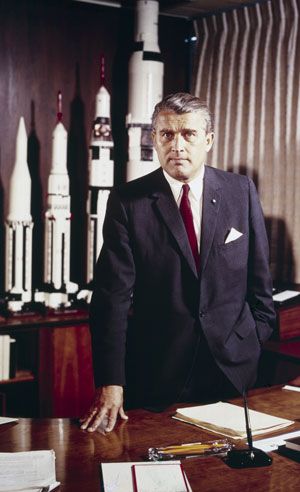
Like Malina, von Braun was born in 1912 and had been drawn to rocketry as a youth. While still an undergraduate, he joined the Verein für Raumschiffahrt (Spaceflight Society), whose 500 amateur members followed the latest developments in the field and also experimented with rockets. By 1932, their work had attracted the attention of the German army, which recruited von Braun and supported his classified doctoral thesis, “Construction, Theoretical, and Experimental Solution to the Problem of the Liquid Propellant Rocket.”
In stark contrast to the U.S. military, the Germans were serious about rockets. By the end of the war, Germany would spend more on rockets than the United States spent on the Manhattan Project—$3 billion versus $1.9 billion. With that kind of largesse, von Braun’s impressive facilities included not just the Peenemünde research and production center but also an additional manufacturing center near Nordhausen.
Although von Braun’s team developed a reusable JATO rocket, their design was apparently never used. That work would have been eclipsed in any event by the far bigger and more sophisticated V-2 rocket. The world’s first production ballistic missile, it burned liquid oxygen and ethyl alcohol, carrying a metric ton of explosives over distances of 320 km. Its guidance system relied on a pair of gyroscopes to steer the fins and vanes; it was not very accurate.
Von Braun’s enterprise produced more than 6,000 V-2s, which were used primarily against London and Antwerp, Belgium, starting in September 1944. The actual manufacturing was done by prisoners from the concentration camp Mittelbau-Dora. As the historian Michael J. Neufeld has documented, von Braun went so far as to handpick detainees with technical qualifications for this work. (The prisoners were worked literally to death. In all, about 12,000 died producing von Braun’s rockets; for comparison, the rockets themselves would kill an estimated 9,000 people, many of them civilians.)
In 1943, the U.S. Army shared the British intelligence reports with von Kármán and Malina and asked if they too could develop a long-range guided missile. They could, they said, and the Army provided the newly renamed Jet Propulsion Laboratory with $3 million for the first year of operation. Von Kármán was named JPL’s director, and Malina was its chief engineer. Construction of a new facility began in the Arroyo Seco, just west of where Malina, Parsons, and Forman had conducted their crude experiments in 1936. Today, JPL still occupies a 72-hectare campus at that site.
By the end of 1944, von Kármán was spending much of his time in Washington, so he resigned his JPL post, and Malina, who had been overseeing daily operations anyway, was soon named acting director.
The lab’s crash program to build a smaller, lighter version of the V-2 called for a small solid-fueled rocket and then a larger liquid-fueled guided missile. The former, dubbed the Private, stood 2 meters tall with a planned range of 18 km. It used asphalt as a fuel with potassium perchlorate as an oxidizer.
The liquid-fueled missile, called the Corporal, was 11 meters high and had a range of 120 km. It burned hydrazine with red fuming nitric acid as the oxidizer—a combination the JPL team had developed and patented. The innovative fuel remained liquid at room temperature, so it needed no cooling system, and it was hypergolic, meaning it ignited spontaneously when its constituents were brought into contact, so no ignition system was required. The same type of fuel would later be used in the Apollo program, to propel the command and service module and the lunar module.
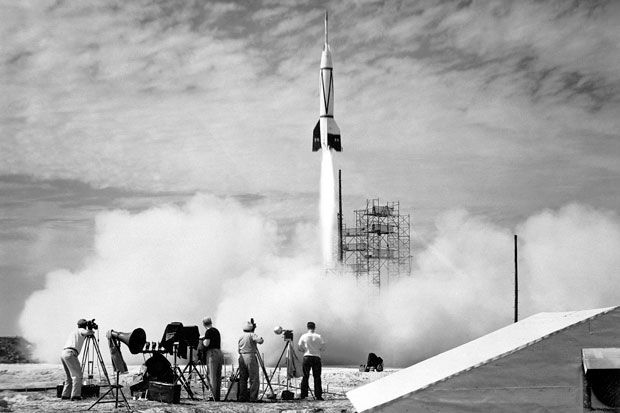
Before his team built the guided version of the Corporal, Malina decided to start with an unguided rocket. It was dubbed the WAC, which stood for either “without attitude control” or “Women’s Army Corps,” because it was the Corporal’s “little sister.” The first was launched at the White Sands Missile Range in New Mexico on 16 September 1945, two weeks after the official end of World War II. A subsequent launch on 11 October reached an altitude of 70 km, nearly to the boundary of space. A more advanced version of the Corporal would later be deployed in Europe as the United States’ first nuclear missile.
Two months after the WAC Corporal launch, Malina’s team returned to White Sands to test the Private. In all, they launched 24 rockets without a single failure. Although never itself used as a weapon, the Private was the direct predecessor of all solid-fueled missiles that came after it.
For Malina, the success of the Private and WAC Corporal was bittersweet. He finally had a high-altitude sounding rocket, but it was already clear that the same machine was also a stepping-stone to a nuclear-armed ballistic missile. Malina was at heart a pacifist who had worked on military technology only because he believed the fascists needed to be defeated. In a 1978 interview, he recalled being “caught up in the wave at the end of the war of hate for war, and fear of the development of the atom bomb, and seeing the things we had been developing for space exploration being used for military purposes.”
Malina tried after the war to convince Caltech’s board of directors to support unclassified high-altitude research based on the WAC Corporal. The board rejected the proposal. In 1946, he and another original member of the Suicide Squad, Martin Summerfield, wrote a paper for the Army describing how technology then available could be used to launch a satellite into orbit. The Army showed no interest.
It seemed the military was interested in Malina’s ideas only as they applied to weapons. Malina decided instead to leave rocketry altogether. In 1947 he resigned from JPL and accepted a position with UNESCO in Paris, a position in which he felt he could work toward peace rather than war.
That wasn’t the only reason for Malina’s departure, however. The FBI had been investigating him since 1942, suspecting him of being a member of the Communist Party and, worse, a communist spy. In 1946, bureau agents raided his house while he was out of town. His abrupt transition from war hero to potential enemy of the state was surely galling.
Was Malina in fact a communist? In 2009 I studied Malina’s considerable FBI file, and I also went through his papers at the Library of Congress. The records show clearly that Malina was likely a member of a Los Angeles branch of the Communist Party in the late 1930s. His FBI file, for instance, contains a copy of a 1939 application to the Communist Party, in what appears to be Malina’s handwriting. He was also no fan of capitalism. In a 1936 letter to his parents, he wrote, “Events in Europe are certainly leading to another war. There seems to be only one hope, overthrowing of the capitalist system in all countries and an economic union of all nations.” Of course, at the height of the Great Depression, countless academics, artists, professionals, and others held such views. And, as JPL historian Erik M. Conway has written, the Communist Party branch to which Malina belonged “dissolved after the shocking announcement of the Soviet Union’s nonaggression pact with Germany in 1939.”
As for espionage, there was perhaps reason to at least suspect Malina. Several security breaches occurred during his tenure at JPL, the most significant involving classified lab documents that turned up in the hands of a Russian courier. According to a 1942 FBI report, at least five unnamed informants identified Malina as a possible spy; the report concluded that “the loyalty of the subject would be questionable if he had to decide between our form of government and that of Russia.” J. Edgar Hoover himself repeatedly prodded the U.S. attorneys to indict Malina, which they finally did in December 1952, for failing to disclose his Communist Party status to the government. His U.S. passport was also revoked.
And yet, despite numerous investigations from 1942 until 1960, the bureau never found any evidence of spying or of more than a passing interest in communism. More likely, Malina was just one of the thousands of wrongly accused Americans ensnared by the Red Scare of the early 1950s. The indictment against him was dismissed in 1954, and his passport was restored four years later.
By then, Malina had resigned from UNESCO, and, now wealthy from his stock in Aerojet, he “cut loose from everything and became an artist,” as he later told an interviewer. He enjoyed some success as a kinetic sculptor, often invoking themes of science and engineering in his work. He never returned to research, although in 1960 he helped found the International Academy of Astronautics with von Kármán and others, to foster international cooperation in space exploration.
Even as Malina’s place among rocketeers faded, von Braun’s grew ever brighter. As the war in Europe transitioned to the Cold War, the U.S. government brought more than 1,500 German scientists, engineers, and technicians to the United States, including von Braun and much of his staff. Nazi party affiliations and war crimes were conveniently overlooked because the Germans’ expertise was now considered crucial in the race against the Soviets. In October 1945, von Braun and part of his team arrived at Fort Bliss, in El Paso, Texas, just a short drive from where Malina’s WAC Corporal was being tested. Von Braun would spend five years there, before being transferred to Huntsville, Ala., where he led the Army’s rocket program. In 1960, he became the first director of NASA’s new Marshall Space Flight Center, in Huntsville, overseeing the development of the heavy-lift Saturn rockets that would carry astronauts to the moon.
The ascendancy of the German engineers within the U.S. program rankled Malina. According to Malina’s son Roger, “He was philosophically bitter that the Nazi engineers had become U.S. space heroes but the founders of U.S. rocketry who had dedicated the war years to working for the Allies had been dispersed.” And in a 1967 article, Malina himself wrote: “Popular opinion, even the opinion of some who should know better, has been that American rocket developments lagged far behind that of Nazi Germany. This belief is false, but myths die hard.”
One last series of experiments is worth noting in this regard. Starting in late 1946, JPL researchers at White Sands assembled and launched two-stage rockets consisting of a WAC Corporal atop a German V-2. The second-stage WAC Corporal would take off just as the bigger missile reached its maximum velocity. On 24 February 1949, one such “Bumper” rocket broke the altitude record by climbing to 393 km, approaching the orbit of today’s International Space Station. The following year, another Bumper became the first rocket to be launched from the newly constructed Cape Canaveral. In so doing, this odd American-German hybrid ushered in the space age.
This article originally appeared in print as “America’s Forgotten Rocketeer.”
About the Author
James L. Johnson is vice president of operations at Systems Seals Inc., in Cleveland, Ohio. He’s currently at work on a book about Frank Malina and the Jet Propulsion Laboratory’s rocket program.